|
To be completed in 2016:
Moragahakanda project on schedule
by Shirajiv Sirimane in Moragahakanda
People have talked about King Parakramabahu for centuries as the
great person responsible for constructing the Parakrama Samudraya. The
Moragahakanda - Kalu Ganga development project would be four times
bigger than the Parakrama Samudraya and people will talk about this
project too for decades to come.
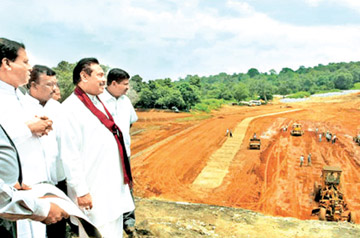
President Mahinda Rajapaksa at the ground-breaking ceremony |
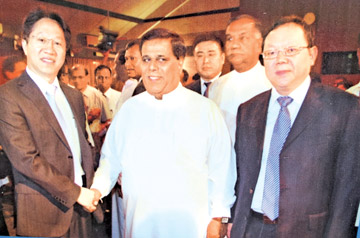
Irrigation and Water Resources Management Minister Nimal
Siripala de Silva during an
inspection tour |

Work goes on apace |
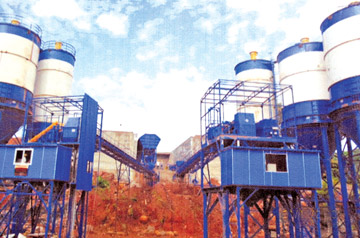
The project |
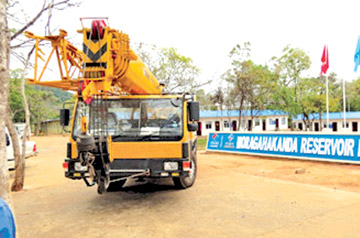
A heavy vehicle at the site |
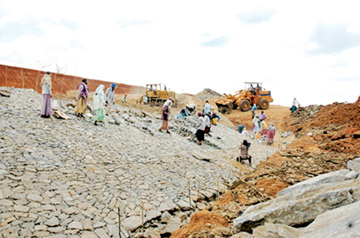
Ongoing development work |
The Moragahakanda - Kalu Ganga development project was first
discussed in 1955 and again in 1977 when the Mahaweli projects were
being implemented. However, it took another 30 years before it finally
got off the ground as the fulfilment of an election pledge under the
Mahinda Chinthana.
However, President Mahinda Rajapaksa identified this need in 2007 and
began working to settle the problems associated with the project. He
also raised funds for the project and assigned the world’s leading
construction companies, Sinohydro Corporation of China to carry it out.
The local inputs added to the project saved millions of rupees to the
country and enabled faster progress.
In addition to providing water for irrigation and drinking purposes,
the US$ 382 million Moragahakanda project would also generate 25 MW of
power, fulfilling a long-term need for domestic and industrial
electricity demand in the North-Central, Northern and Eastern Provinces.
Annual fuel cost savings with the hydro-power produced will be quite
substantial.
The project would also enable a flood control system, which would be
another advantage.
The project would also, most importantly, provide domestic and
industrial water to Anuradhapura, Trincomalee, Polonnaruwa and Matale
districts for the development of agriculture in the North, East and
North-Western Provinces.
The direct benefits include an increased rice yield per hectare with
an additional agricultural production of 109,000 tons annually. The net
annual agricultural benefits will be US$ 27.7 million in financial
terms.
Sinohydro Corporation of China was given the responsibility for the
construction work. When completed, the Moragahakanda reservoir would be
the second largest ever built in Sri Lanka, after the Victoria project.
Unique record
The project would also create a unique record by being on schedule
all the time. The construction of the Moragahakanda Project, being
carried out by Sinohydro Corporation, is on schedule.
The Chinese engineers hope to deliver the project before July 22,
2016, right on schedule. “We have now completed 25 percent of the
project,” said Project Director, Moragahakanda Reservoir, Headwork
Projects, Li Shizhong, who is personally supervising the progress. He is
the key person representing the parent company, Sinohydro Corporation of
China He said that since the commencement of the project, they were
happy with the work so far and also the support and guidance they
received from both the Mahaweli Authority and the Irrigation Department.
The infrastructure has now fallen in to place to make the final
operation run smoothly.
These include the site office, bridges, roads, workshop and
residential complex, works depot, metal crusher, cement mix and grinding
plant.
The expertise of the 50-year-old company has a major positive impact
on the work. The latest equipment, some of which have been seen in Sri
Lanka for the first time, also helped speed up proceedings, enabling the
project to run ahead of schedule.
The Sinohydro Corporation too has invested on the project by way of
HR resources and by bringing down the most updated heavy machinery.
Shizhong said that some of the key decisions that the company took were
firstly, to maintain the picturesque environment of the area and
secondly, to award every possible sub-contract to people who were
relocated due to the project.
“This has proved very successful and today one can see Sri Lankans
working hand in hand with our staff in perfect harmony,” he said.
The economic benefits of the project are already visible in the area
as the quality of life has risen thanks to the project. “Over 150 direct
employment opportunities have been provided to the villagers and we
estimate that over five to six million rupees are being distributed to
theses workers and others who are indirectly employed every month.”
He said they feel quite at home working in Sri Lanka, mainly because
of the support they get from the Mahaweli Authority and the residents.
“We have even braved the rain to meet our deadlines,” he said.
Safety first
As in any other of their projects across the world, he said safety
was a prime concern and not a single major accident had yet been
reported. “Youth who are working with us also get foreign exposure by
working with our staff. This would be a major plus point when they look
for jobs in the future,” he said.
Sinohydro Corporation, which has operations in more than 58
countries, is a Chinese state-owned hydro-power engineering and
construction company. It engages in architectural projects, electric
power investment, housing, property and real estate, research and
development and design and manufacture of construction equipment.
Founded in 1955 and based in Beijing, it ranks 24th among the Top 225
international contractors listed by the Engineering News Record.
Currently, Sinohydro has over 241 projects completed or under
construction in 61 countries, with a total contract value of around US$
25.5 billion.
Economic benefits
The completion of the Moragahakanda reservoir project will increase
the island's agricultural productivity from 165 percent to 185 percent,
with a total output value of US$ 17 million.
The average annual fish production potential of the reservoir is
estimated to be around 4,700 tons per year, representing a net benefit
of US$ 1.67 million annually. Farmer income is expected to increase by
80 percent, once the Moragahakanda reservoir project is completed. It is
also expected to save US$ 2.2 million locally, by supplying water to
households and for industrial purposes.
Irrigation and Water Resources Management Minister Nimal Siripala de
Silva has said the Government handed over the Moragahakanda Project
under the Mahaweli River Development Program to Sinohydro Corporation of
China due to their unblemished track record. “We are grateful for the
assistance given by China,” he said.
“Once the Moragahakanda project is completed, a large number of
farmers in the northern part of this country will benefit immensely,” he
said.
An official from the Mahaweli Authority said that 1,581 families had
to be relocated under this project. “We have already resettled 221
families in better places and compensation too had been paid to them,”
he said. The relocation is to be completed by 2015.
It is expected that the annual agricultural benefits from paddy
cultivation alone, as a result of the project, would be around US$ 30.1
million while the fresh water fish breeding industry would contribute
around Rs. 1.67 million to the national economy via benefits from this
project. Most importantly, through power generation, the country would
annually save US$ 2.49 billion.
Project fact file
* Location: Central and North Central Provinces
* Project configuration:
- Construction of two major reservoirs, Moragahakanda and Kalu Ganga
- A conveyance system consisting of two tunnels and transfer canals
- A power house of 20 MW installed capacity.
* Objectives:
- To provide irrigation water facilities to 81,422 ha in the Dry Zone
- Potable and industrial water supply to Anuradhapura and Trincomalee
towns
- Generation of electricity by hydro power
Principal project features
Moragahakanda Reservoir
Type of Dam: A roller compacted concrete main dam and two rock-filled
saddle dam
Maximum dam height: 65 metres
Active storage: 521 million cubic metres
Kalu Ganga Reservoir
* Type of dam: A rock-filled main dam and two saddle dams, one
rock-filled and the other, earth
* Maximum dam height: 67 metres |

